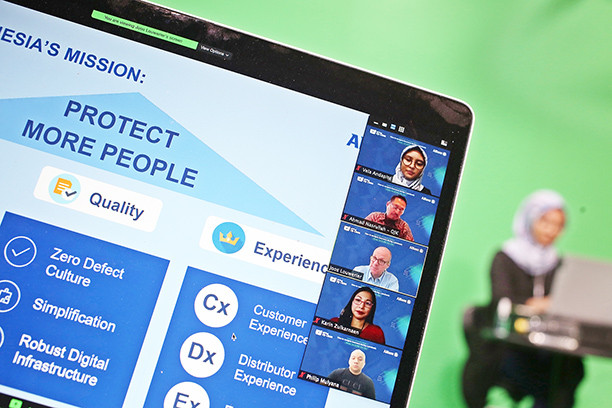Popular Reads
Top Results
Can't find what you're looking for?
View all search resultsPopular Reads
Top Results
Can't find what you're looking for?
View all search resultsInsurance ‘myths’ contribute to public reluctance
Insurance penetration in Indonesia has been low for a long time, with 2017 data from the World Bank pointing to 1.3 percent life insurance premium volume to GDP.
Change text size
Gift Premium Articles
to Anyone
 Insurance talks: Joos Louwerier, country manager and president director of Allianz Life (third from top), talks during The Jakarta Post webinar Jakpost Up Close titled “How to navigate insurance during a
pandemic” in Jakarta on June 29, 2020. Ahmad Nasrullah of the Financial Services Authority (second from top), Allianz Life Indonesia chief of
marketing Karin Zulkarnaen and financial coach Philip Mulyana attended the event, which was moderated by Vela Andapita (top) of The Jakarta Post. (JP/Wienda Parwitasari)
Insurance talks: Joos Louwerier, country manager and president director of Allianz Life (third from top), talks during The Jakarta Post webinar Jakpost Up Close titled “How to navigate insurance during a
pandemic” in Jakarta on June 29, 2020. Ahmad Nasrullah of the Financial Services Authority (second from top), Allianz Life Indonesia chief of
marketing Karin Zulkarnaen and financial coach Philip Mulyana attended the event, which was moderated by Vela Andapita (top) of The Jakarta Post. (JP/Wienda Parwitasari)
S
everal myths surrounding insurance have contributed to the reluctance among the public at large to purchase its products, according to major insurer Allianz Life Indonesia.
Allianz Life Indonesia chief marketing officer Karin Zulkarnaen explained that these myths persisted despite rising awareness about the importance of being insured due to the pandemic. Insurance penetration in Indonesia has been low for a long time, with 2017 data from the World Bank pointing to 1.3 percent life insurance premium volume to GDP.
During The Jakarta Post’s webinar Jakpost Up Close on Monday, titled “How to navigate insurance during a pandemic”, Karin debunked the four most common insurance myths.
Young people do not need insurance
“When you’re young, you think you’re bulletproof,” Karin said. “Unfortunately that is not always true”.
She noted that the average age of a person making an insurance claim was 37 years old, with many illnesses deriving from unhealthy lifestyle choices. Apart from promoting a healthy lifestyle to prevent unwanted risks, insurance has become a financial vehicle that more young people are gravitating toward to hedge against risks.
“The cost of having insurance is cheaper when you’re younger because you have lower risk, and hence, a lower premium,” Karin noted.
Insurance is expensive
Financial coach Philip Mulyana said during the webinar that people could essentially determine for themselves the kind of protection they wanted based on how much they were willing to pay, as insurance “is a flexible product that you can structure" accordingly.
“Insurance companies can cover a huge amount of money with the small amount that you spend,” said Philip.
“The price of an insurance premium depends on your coverage and age. The more coverage you want, the higher the premium,” Karin said.
She explained that an insurance premium included the cost of risk and cost of administration to cover the customer’s policy. If the product has a cash value or an investment component, it also builds up to the pricing of the policy.
Indonesians’ purchasing power has been disrupted by the COVID-19 pandemic, which has resulted in business closures, layoffs and furloughs across all business sectors. This is evident in recent consumer surveys and inflation rate touching the lowest level in 20 years at 0.07 percent in May.
My employer covers my insurance
The difference between what is offered by employers and independent health insurance is that the benefit of the former is only offered as long as the person is employed to that company, Philip explained.
“If you are ill and you can’t continue your employment, you can’t continue that health benefit,” Philip noted.
For Karin, the problem she has encountered frequently when discussing insurance coverage by employers is that many times the employee is not aware of the degree of coverage.
“Find out what’s covered and whether your spouse and dependents are also covered,” Karin said.
This is an issue common to the “sandwich generation”, or those who have to provide for both their young family and old parents at the same time. These aging parents will need protection as well and might not be covered by existing insurance plans, Karin noted.
It is difficult to access insurance
“Information is available, you just need to do the research and spend time to read the offer,” Karin suggested.
Customers can engage with insurance companies on social media, as well as other digital platforms, including buying policies on e-commerce platform Bukalapak or the Gojek app.
Throughout 2019, 92 percent of policies were submitted electronically, while 15 to 20 percent of issuance policies were delivered within 5 minutes, down from policy issuance of seven to nine days prior. Aside from that, the share of e-policies has reached 46 percent.









